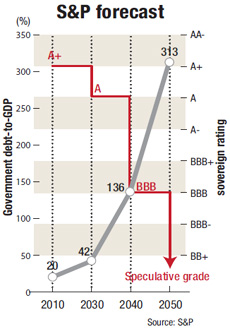- California Assembly OKs highest minimum wage in nation
- S. Korea unveils first graphic cigarette warnings
- US joins with South Korea, Japan in bid to deter North Korea
- LPGA golfer Chun In-gee finally back in action
- S. Korea won’t be top seed in final World Cup qualification round
- US men’s soccer misses 2nd straight Olympics
- US back on track in qualifying with 4-0 win over Guatemala
- High-intensity workout injuries spawn cottage industry
- CDC expands range of Zika mosquitoes into parts of Northeast
- Who knew? ‘The Walking Dead’ is helping families connect
Korea may follow Greek path
Experts call for stronger steps to lower debts
This is the first of a three-part series analyzing the seriousness of Korea’s debt problem and suggesting recommendations to address the issue ― ED.
By Kim Rahn
Korea acts as if it were an indebted man who uses multiple credit cards to cover his maturing bills.
It should start to fight this vicious cycle now or risk facing the level of indebtedness that pushed Greece to the brink of bankruptcy in 2010, 20 years from now according to analysts.
Even if the government’s repeated pledge of diligently addressing the problem is to be believed, the numbers look chilling and the thought of the next generation being left with a mountain of debt could be even chillier.
Debts at households, the government and businesses snowballed to 3.78 quadrillion won ($3.51 trillion) in 2013, almost three times the nation’s gross domestic product (GDP).
Economists are therefore calling for prompt action to prevent a potential explosion in the future.
A Standard & Poor’s report, titled “Global Aging 2013: Rising to the Challenge,” showed that Korea’s government debt compared to GDP, which was 20 percent in 2010, could grow to 42 percent by 2030, 136 percent by 2040 and 313 percent by 2050.
It cites Korea’s rapidly aging population and increasing social spending as the main factors. The hypothetical figure for 2040 is near the level of Greece’s 143 percent in 2010.
The report forecast Greece’s government debt to GDP may reach 303 percent by 2050, lower than the scenario for Korea.
Lee Ju-yeol, the newly appointed governor of the Bank of Korea (BOK) who will take office in April, said during Wednesday’s National Assembly confirmation hearing that Korea’s debt in its current form is unsustainable posing a major risk to the country’s economic vitality.
Sovereign crisis
The Ministry of Strategy and Finance said in February that public sector debt totaled 821.1 trillion won as of 2012, representing about 64.5 percent of GDP.
The government’s previously announced figures only reported debt held by the central and municipal governments, but following the latest guidelines from the International Monetary Fund (IMF), it has included debt held by non-financial public companies in this year’s figure.
However, it maintains that the current level is manageable, because the debt held by central and local governments, at 504.6 trillion won, was 39.7 percent of GDP, lower than the OECD average of 107.4 percent, Japan’s 210.2 percent and the United States’ 103.5 percent.
However, many experts say the nation should include debt held by public financial firms and institutions to the nation’s total debt figure.
According to the Korea Economic Research Institute, public financial firms’ debt stood at 289.7 trillion won and estimated liabilities to be paid to retiring civil servants and soldiers as pensions was 467.4 trillion won.
“When these are included, a broad sense of public sector debt will be 1.6 quadrillion won, more than 131 percent of 2012’s GDP,” researcher Kim Young-shin at the institute said.
“If we include estimated liabilities for the national pension, the broader sense of debt becomes 2.1 quadrillion won, about 167 percent of the GDP.”
Of the public sector debt, some market watchers are keenly tracking that held by public firms, which has soared in recent years as the firms have had to cover the costs of major government-led construction projects.
Moody’s Investors Service said in a November report that non-financial public firms’ debt can affect Korea’s sovereign rating.
“Because of the policy role of public-sector corporations and the oversight of both the government and the National Assembly, Moody’s considers that public-sector corporate debt presents a contingent liability on the government’s balance sheet. The already high level of such debt presents risks to the ability of such corporations to service their debt in a time of future economic stress,” the report said.
Spending cut by households, businesses
Apart from public sector debt, household debt has emerged as a headache for the economy, reaching 1.02 quadrillion won last year, exceeding the 1 quadrillion won mark for the first time.
According to the finance ministry, Korea’s household debt to disposable income was 163.8 percent in 2012, higher than the OECD average of 135.7 percent in 2011, the latest figure available. It was also higher than figures for other major economies, including 120.1 percent for the U.S., 160.4 percent for Britain, 131.7 percent for Japan and 95.1 percent for Germany.
Naturally, high debt limits consumer spending.
According to the BOK, households’ surplus funds, meaning the money which households did not spend after earning or borrowing, was 87 trillion won, the largest ever.
“But it does not mean households have become more affluent, because the surplus came because people reduced spending,” Kim Young-hun, head of BOK’s flow of funds team, said.
“More money was left because, for example, people who used to have expensive steak had a bowl of ox bone soup instead. The decrease in consumption will limit economic revitalization. Even though you have large assets, it is a different matter whether you can spend them,” he said.
The business sector has also been affected by the snowballing debt.
Companies typically finance their investments through loans, but the problem is that their debt is growing faster than their profitability. Many big companies have already been hit by liquidity troubles in the last several years with notable examples being STX Group and Ssangyong Engineering & Construction.
While a debt ratio of 200 percent is said to be a stable level, 18.8 percent of large firms had more than this as of last June, according to the BOK. About 55 percent of such firms suffered losses in the first half of last year.
Sixty-five percent of companies also had large portions of short-term loans, with more than half of these expected to mature within a year. The situation has further been complicated by the fact that most of them generated revenue of only 32 percent of the short-term loans, resulting in an urgent need to secure liquidity to repay their debt.
“Large debt in the business sector is what caused the problem back in 1997,” Mauro Guillen, professor at the Wharton School of the University of Pennsylvania, said. “It is key to keep an eye on investments made by chaebol using debt, and on the concentration of risk within the same chaebol.”
















